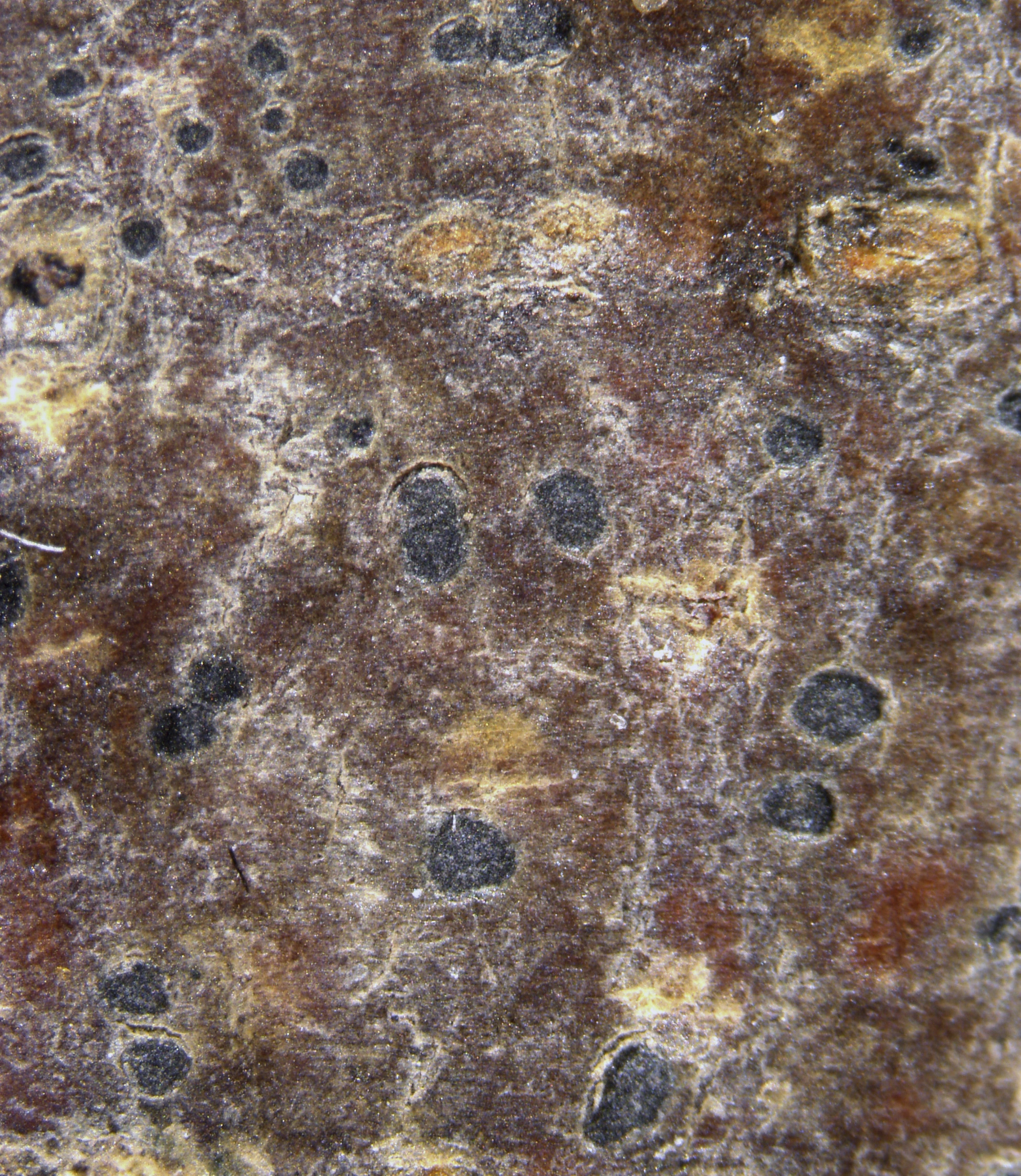Naevia punctiformis
Naevia punctiformis collected from a young oak in the British Islands in 1807 (BM000974443, type material of Graphis microscopica Borrer).
Naevia punctiformis is a common and widely distributed pioneer species on deciduous trees. It is easily identified by the brownish black, maculate to lirellate apothecia on an indistinct, non-lichenized thallus. The colorless spores are 3–5-transversely septate. The apical cell is not enlarged.
- Innhold
- Description
- Ecology
- Distribution in Norway and the Nordic countries
- Global distribution
- Similar species
- Remarks
Description
Thallus
The thallus is thin and indistinct; however, it often discolors the host bark white to pale cream. The margin is not determinate or bordered by a thin brown line. Photobionts are absent.
Fruitbodies
The apothecia are either level with the thallus or indistinctly raised, brownish black, and without pruina. Their shape varies from rounded, elliptical or angular to long elongate or even indistinctly branched. They are 0.2–2.0 × 0.2–1.2 mm in size and 50–100 μm tall. The disc is flat to slightly convex and matt or weakly glossy. A thin layer of bark tissue is often observed along the apothecial margin, and patches of host bark may be present on the apothecial disc as well.
The epithecium is 5–20 μm tall and olive-brown in color.
The hymenium is colorless and 35–70 μm tall.
The hypothecium is unpigmented and up to 15 μm tall.
The paraphysoids are 1–1.5 μm wide. Their tips are slightly widened to 2–2.5 µm.
The asci are obovoid to subglobose, without stipe, 25–47 × 18–30 µm, and 8-spored.
The spores are colorless, narrowly obovoid to obovoid, 14–25 × 5–9 μm in size, and divided by 3–5 transverse septa. An enlarged and undivided apical cell is not developed.
Anamorph
Pycnidia are brownish black, immersed in the thallus, and ca 100 µm in size. The wall is olive-brown. The rod-shaped conidia are 5–7 × ca. 1 μm in size.
Chemistry
The thallus does not react with C, K, KC, Pd, or UV (C–, K–, KC–, Pd–, UV–). Lichen secondary compounds have not been detected by TLC.
The hymenium reacts I+ blue (or blue mixed with red) and KI+ blue. A KI+ blue ring structure has been observed in the asci.
The brown pigment in the epithecium and in the wall of the pycnidia changes to greenish in K solution.
Naevia punctiformis collected in France (BM001107440, type material of Arthonia punctiformis var. glaucescens Ach.).
Ecology
Naevia punctiformis is a pioneer species typically found on smooth bark of deciduous trees. It often occurs on branches and twigs, or were competition by other lichen species is low. In Norway it is found in natural and anthropogenic habitats, but appears to avoid the shady interior of forests. Common host trees include alder (Alnus spp.), aspen (Populus tremula), European ash (Fraxinus excelsior), European beech (Fagus sylvatica), birch (Betula spp.), common hazel (Corylus avellana), oak (Quercus spp.), rowan (Sorbus aucuparia), sea buckthorn (Hippophae rhamnoides), small-leaved lime (Tilia cordata), willow (Salix spp.) and wych elm (Ulmus glabra).
Naevia punctiformis is widely distributed in temperate to boreal climates of the northern Hemisphere.
Distribution in Norway and the Nordic countries
Naevia punctiformis is common and widespread in the lowlands across Norway, with few records from mountain areas. In the Nordic countries, it is also known from Denmark, Finland and Sweden.
Global distribution
Naevia punctiformis is widespread in temperate to boreal regions of Europe, North America and East Asia.
Naevia punctiformis collected in Sweden (BM001107440, type material of Arthonia punctiformis var. olivacea Ach.).
Similar species
Naevia punctiformis is a variable species with respect to apothecia shape and spore characters. With some experience, however, it is easily identified in the field. Only young or poorly developed individuals of the variable Arthonia radiata may proof difficult to distinguish with certainty. The lack of photobiont cells, typically less elongated or branched apothecia, and presence of spores with more than three septa indicate Naevia punctiformis.
Remarks
Naevia punctiformis is a species complex in Norway. Five genetically and morphologically recognizable species have been recognized by Moen (2019). Three of them are common and show a wide overlap in distribution and ecology. However, the naming of these species within Naevia punctiformis is not yet clear and needs further study.
Literature
Moen SV (2019). Molecular systematics and species delimitation in Coniocarpon and Arthonia punctiformis s.lat. in Norway. Master’s thesis, NTNU, Faculty of Natural Sciences, Department of Natural History, 61 pp.
Sundin R (1999). Phylogenetic and taxonomic studies within Arthonia Ach. (Ascomycetes, Arthoniales). Botaniska institutionen, Stockholms universitet, Stockholm.



